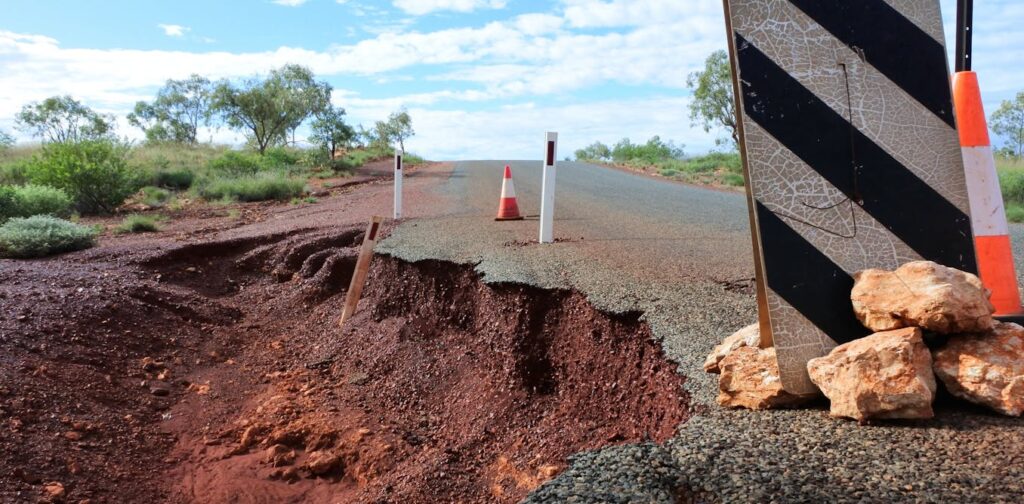
Australia, home to one of the world’s most extensive road networks spanning nearly 900,000 kilometers, is grappling with an infrastructure crisis exacerbated by climate change. Over 80% of these roads traverse rural or remote areas, making maintenance a formidable and costly challenge. As the impacts of climate change intensify, road workers, engineers, and transport departments face mounting difficulties, with potholes becoming a common sight across the nation.
In 2023, record flooding devastated a crucial bridge at Fitzroy Crossing in Western Australia, creating chaos and disruption. The following year, bushfires closed the Eyre Highway, a vital link between South Australia and Western Australia, only to be followed by subsequent floods. These events have left communities isolated for months, highlighting the vulnerability of Australia’s road infrastructure.
Climate Change: A Catalyst for Deterioration
Extreme weather events, driven by climate change, are accelerating the deterioration of Australia’s roads. While extreme heat and bushfires pose significant threats to the southern and eastern regions, it is the water damage from intense rainfall and floods that currently wreaks the most havoc. Projections indicate that floods will become more frequent and severe, particularly in the northern and eastern parts of the continent.
The newly unveiled National Climate Action Plan underscores the urgent need to upgrade Australia’s transport networks to withstand these climatic changes. However, it acknowledges the impracticality of climate-proofing the entire network, urging authorities to prioritize maintaining essential lifelines.
Queensland: The Frontline of Vulnerability
Queensland, with the largest road network among Australian states and territories, is particularly vulnerable. Spanning approximately 180,000 kilometers, two-thirds of these roads navigate rural and remote regions, complicating monitoring and maintenance efforts. Notably, nearly 40% of Queensland’s roads are constructed on black clay soils, which expand when wet and contract when dry, leading to cracking and accelerated failure.
Intense rainfall and flooding events are now primary culprits behind road closures and pavement damage, isolating communities and disrupting essential freight routes. The recent floods in northern Queensland left supermarkets empty and disrupted industries reliant on dependable transport connections, such as agriculture and mining.
In 2022, the Queensland government allocated A$350 million to repair roads damaged by floods, yet maintenance costs continue to soar. By 2023-24, the state faced an estimated A$8.6 billion in necessary but unfunded road renewal and maintenance, up from A$7.8 billion the previous year.
Building Resilience: A National Imperative
In 2023, a government inquiry recommended several strategies to bolster the resilience of Australia’s roads. It concluded that climate-proofing the entire network was unrealistic due to cost, timeframe, and staffing constraints. Instead, the focus should be on enhancing critical corridors and ensuring rapid reopening after closures.
Coordinating road maintenance across federal, state, and local governments has long been a challenge, and this complexity is expected to increase. Effective response to large-scale events will necessitate improved collaboration to keep essential road corridors open for freight and community access, as well as strengthening backup options where feasible.
Preventative maintenance must also be intensified to address chronic repair backlogs affecting road drainage, shoulders, and surfaces. Authorities need to improve data collection and sharing to guide investment, target maintenance, and enhance road safety.
Innovative Solutions for a Sustainable Future
As climate change continues to impact Australia’s roads, innovative approaches to road construction and maintenance are becoming increasingly crucial. Foamed bitumen roads, for instance, offer greater flood resistance, while incorporating crumb rubber from old tires into road surfaces enhances durability.
Recycling old asphalt pavement and waste glass as aggregate for new roads can reduce waste and emissions. Additionally, intelligent road rollers equipped with real-time monitoring capabilities ensure more even compaction of new road layers, improving quality.
Despite these advancements, widespread adoption has been hindered by cost concerns, supply chain challenges in regional areas, and reluctance to embrace new technologies. Policymakers can accelerate progress by implementing procurement rules that prioritize stronger, more resilient, and low-carbon materials.
As climate change continues to batter Australia’s roads, the need for proactive measures becomes increasingly urgent. Without decisive action, the damage will only intensify, rendering traditional methods obsolete. The path forward lies in building greener, stronger roads that can withstand the challenges of a changing climate.







